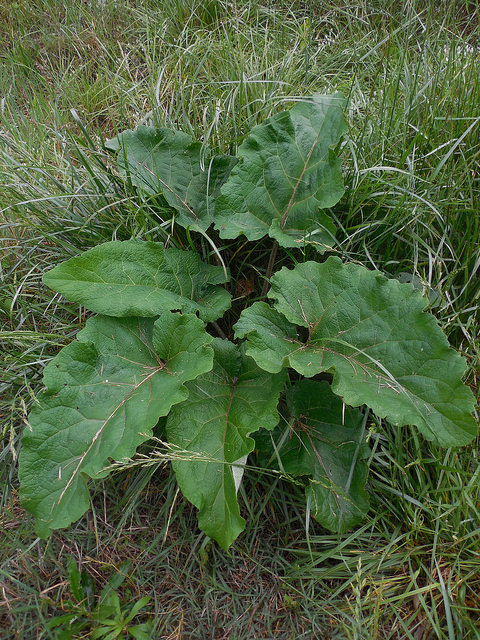Map Snapshot

















179 Records
Status
"Naturalized from Europe; Newfoundland to British Columbia, south to Virginia, West Virginia, Missouri, Kansas and California"(Reed, 1964).
Seasonality Snapshot
Source: Wikipedia
| Arctium minus | |
|---|---|

| |
| Flower heads (capitula) | |
| Scientific classification | |
| Kingdom: | Plantae |
| Clade: | Tracheophytes |
| Clade: | Angiosperms |
| Clade: | Eudicots |
| Clade: | Asterids |
| Order: | Asterales |
| Family: | Asteraceae |
| Genus: | Arctium |
| Species: | A. minus
|
| Binomial name | |
| Arctium minus | |
| Synonyms[1] | |
|
Synonymy
| |
Arctium minus, commonly known as lesser burdock,[2] little burdock, louse-bur, common burdock,[3] button-bur, cuckoo-button,[3] or wild rhubarb,[4] is a biennial plant native to Europe.
Description
[edit]
Arctium minus is a biennial plant growing up to 1.8 metres (6 ft) tall[5][6] and form multiple branches. It is large and bushy. The leaves are up to 50 cm (20 in) long and ovate. The lower leaves are heart-shaped and have very wavy margins. Leaves are dark green above and woolly below. It grows an extremely deep taproot, up to 30 cm (12 in) into the ground.[7][8] The plant produces flowers in its second year of growth, from July to October. The flowers are prickly and pink to purple in color. The flower heads are about 2 cm (3⁄4 in) wide, surrounded by a cluster of bracts.[5][6] The outer bracts end in hooks causing a hook-and-loop effect after the flower head dries, when the bracts will attach to humans and animals to transport the seedhead.[9]
The flowers resemble and can be easily mistaken for thistles, but burdock can be distinguished by its extremely large leaves and its hooked bracts.
Distribution and habitat
[edit]The plant is native to Europe,[10] but has become introduced elsewhere such as Australia, North and South America, and other places.[11][12][13][14]
Uses
[edit]The leafstalks (up to a year old), leaves,[6] and flower stalks can be eaten raw or cooked. The roots are edible boiled with a change of water,[5] though become too woody to eat in plants over a year old.[15] The leaves can also be used to make herbal tea.[6]
References
[edit]- ^ The Plant List Arctium minus (Hill) Bernh.
- ^ BSBI List 2007 (xls). Botanical Society of Britain and Ireland. Archived from the original (xls) on 2015-06-26. Retrieved 2014-10-17.
- ^ a b "Arctium minus". Germplasm Resources Information Network. Agricultural Research Service, United States Department of Agriculture. Retrieved 2 January 2018.
- ^ USDA PLANTS information
- ^ a b c Elias, Thomas S.; Dykeman, Peter A. (2009) [1982]. Edible Wild Plants: A North American Field Guide to Over 200 Natural Foods. New York: Sterling. p. 112. ISBN 978-1-4027-6715-9. OCLC 244766414.
- ^ a b c d Francis-Baker, Tiffany (2021). Concise Foraging Guide. The Wildlife Trusts. London: Bloomsbury. p. 80. ISBN 978-1-4729-8474-6.
- ^ John W. Thieret, William A. Niering, and Nancy C. Olmstead. National Audubon Society Field Guide to North American Wildflowers, Eastern Region, Revised edition. Chanticleer Press, Inc, 2001. ISBN 0-375-40232-2
- ^ Richard H. Uva, Joseph C. Neal, and Joseph M. Ditomaso. Weeds of the Northeast. Cornell University Press, 1997. ISBN 0-8014-8334-4
- ^ Rose, Francis (1981). The Wild Flower Key. Frederick Warne & Co. pp. 386–387. ISBN 0-7232-2419-6.
- ^ Altervista Flora Italiana, Lappola bardana minore Arctium minus (Hill) Bernh. includes photos plus European distribution map
- ^ Flora of North America, Vol. 19, 20 and 21 Page 170 Common or lesser burdock, petite bardane, cibourroche, chou bourache, bourrier, Arctium minus (Hill) Bernhardi, Syst. Verz. 154. 1800.
- ^ Biota of North America Program 2014 county distribution map
- ^ Marticorena, C. & M. Quezada. 1985. Catálogo de la Flora Vascular de Chile. Gayana, Botánica 42: 1–157
- ^ Atlas of Living Australia
- ^ Benoliel, Doug (2011). Northwest Foraging: The Classic Guide to Edible Plants of the Pacific Northwest (Rev. and updated ed.). Seattle, WA: Skipstone. p. 55. ISBN 978-1-59485-366-1. OCLC 668195076.
External links
[edit]













